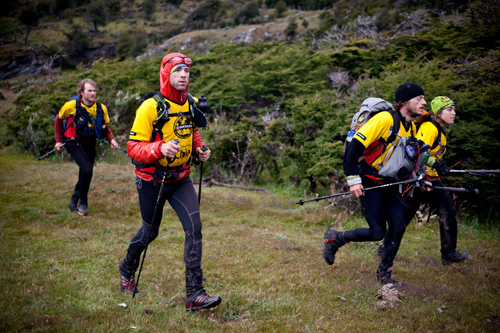My head is still spinning. The experience has not yet sunk in. Last month, after almost seven straight days of racing — and hundreds of miles traveled on bike, foot, and kayak — Team GearJunkie.com completed the Wenger Patagonian Expedition Race in Tierra del Fuego, Chile, and managed to grab a fourth-place finish.

The team, which included myself and three teammates, a woman and three men who traveled together the entire race, traded jokes and encouragement. We shared food and drafted in line on the bikes. We huddled together for warmth at night.
In adventure racing, the clock never stops. You set out from the start line geared up and ready for long days — and even longer nights — of perpetual motion. During events like the Wenger Patagonian Expedition Race, an annual competition that is one of the longest races on the planet, some teams might go 48 hours between sleep.
This year in Patagonia, we luxuriated and slept one hour the first night of the race, surrendering at 3a.m. on the floor of an abandoned farm shack after a hard day of trekking and mountain biking. The alarm on my wristwatch pierced the dark air before dawn, a shrill beep that got us up and hiking again toward a checkpoint still miles south over arid terrain.
We ate “breakfast” on the move, Clif Bars and cashews washed down with electrolyte drink — the first sustenance on a typical 6,000 or 7,000 calorie day. When done, we ran in a line as the sun rose, jumping cracks in the dirt, the expanse of Tierra del Fuego falling forever ahead.

You go on like this for days. Your mind shifts, your focus narrows. In an adventure race, things get basic and primal. It’s you and the land and the task ahead. Eat. Drink. Bike. Trek. Paddle. Navigate. And repeat.
You follow a topo map, the sole guide. GPS is not allowed. You trust a compass needle to direct your bearing through wilderness harsh and deep. In Patagonia, pushing far south in the Darwin Mountain Range, we went for days without signs of human passage.
Gear keeps you alive. A headlamp illuminates a cliff edge in the night. Wool base layers are your second skin, wearable for days, warm even when wet. Your shell jacket — a thin sheen, waterproof and breathable — saves you when it sleets and snows, as it did one frigid night in the mountains near the end in our event.

Gear makes you fast. In an adventure race, you count ounces and throw heavy items out. You balance survival with speed, a two-pound tent that flaps in the wind, a tiny sleeping bag just barely warm enough for the job. Running shoes — not boots — move you for hours and days on end in mountains, swamps, forests, and arid land.
Trekking poles save your knees. Tiny pills purify water. You haul your food between distant resupply drops, all calories counted, your bars, granola, gels, chocolate, cookies, and nuts packaged and divvied for days.
In the end, your teammates push you on. I carried one teammate’s backpack on a long run, doubling my load when I was feeling good. Later, I bonked on a bike leg through the mountains, and then my gear got divided up to the team.

Photo by T.C. Worley
We pedaled up and up that day to a mountain pass. It was the third day of the race, and the halfway point was just barely then in sight. On top of the pass, mountain peaks popped out of the clouds. Tierra del Fuego sprawled out — a howling wilderness of rivers, lakes, and jagged rock — to a horizon ahead.
I clicked into a high gear and tucked. Wind roared as the team coasted downhill — the last road we’d see on the course. At the bottom, we left our bikes, shouldering packs and heading on foot into the woods.
The maps directed us ever south, a trajectory toward the tip of the South American continent. We raced on, straining to catch a team ahead. The end of the Earth was beyond, and the finish line somewhere, too.








